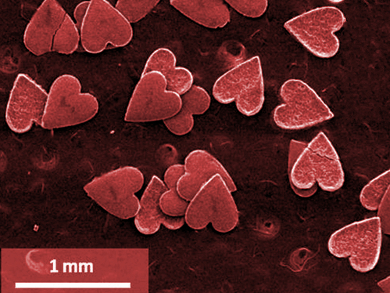The positioning of free-standing metal–organic framework (MOF) films is required for potential applications in areas such as sensors and solar cells. However, it is difficult to form and position the desired film structures on various substrates.
Dong-Pyo Kims, Pohang University of Science and Technology, Korea, and colleagues have developed a micro-confined interfacial synthesis (MIS) approach to synthesize free-standing MOF structure. The method uses a polymeric mask to restrict the reactive contact between the aqueous metal solution and organic ligand solution for nucleation and growth of MOF crystals in a size-selective manner. As a result, free-standing 2D MOF superstructures with controlled shapes can be formed (example pictured).
The obtained MOFs films could be selectively positioned at specific sites on various substrates by using a simple contact transfer method. The MIS technique enables both structuring and positioning of MOFs, and is potentially compatible with manufacturing protocols for various microelectronic devices, particularly components in flexible electronics, supercapacitors, and batteries.
- Direct Fabrication of Free-Standing MOF Superstructures with Desired Shapes by Micro-Confined Interfacial Synthesis,
Jin-Oh Kim, Kyoung-Ik Min, Hyunwoo Noh, Dong-Hwi Kim, Soo-Young Park, Dong-Pyo Kim,
Angew. Chem. Int. Ed. 2016, 55, 7116–7120.
DOI: 10.1002/anie.201601754




